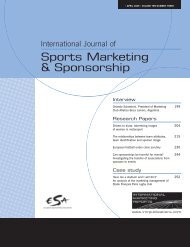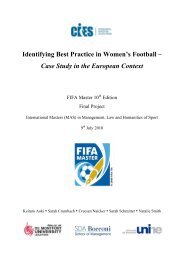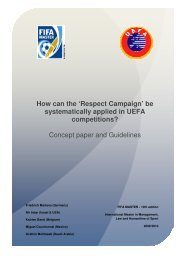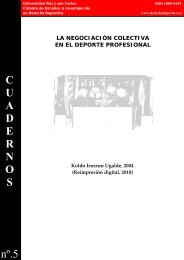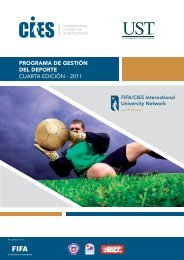4 - FIFA/CIES International University Network
4 - FIFA/CIES International University Network
4 - FIFA/CIES International University Network
You also want an ePaper? Increase the reach of your titles
YUMPU automatically turns print PDFs into web optimized ePapers that Google loves.
EVENTS<br />
Mané Garrincha Stadium (L), Arena da Baixada (C), Vivaldão Stadium (R) - JorgeBrazil<br />
Stadia<br />
The stadium issue is the most contentious<br />
criticism of Brazil’s preparations and will likely<br />
remain so. The overall cost of stadia stands at<br />
$2.7 billion: $226 million for each.<br />
“In terms of stadia, the plan was to keep<br />
government funds restricted to infrastructure<br />
improvements and create partnerships between<br />
stadium owners and corporations to fund<br />
stadium expansion and renovation plans,”<br />
Minto notes. “However, with football club’s on<br />
task to meet <strong>FIFA</strong> deadlines to raise funds for<br />
renovations of their stadia, progress was slow,<br />
and recently Morumbi, a major stadium in Sao<br />
Paulo, the financial centre of the country and<br />
Brazil’s largest city, was crossed off of <strong>FIFA</strong>’s list.”<br />
<strong>FIFA</strong> would like to have Sao Paulo, the<br />
largest city in Latin America, as a site, but<br />
none of the current proposals has met with the<br />
world governing body’s approval. The idea of a<br />
completely new stadium was floated - local club<br />
Corinthians would be the primary tenant and the<br />
national team would frequently play there - but<br />
Sao Paulo officials will not commit municipal<br />
monies to the project.<br />
Another major local club, Palmeiras, is<br />
renovating its stadium along <strong>FIFA</strong> guidelines,<br />
but it has been proposed only as a training<br />
ground, not as a venue. Capacity at the Palestra<br />
Italia will increase from 30,000 to 45,000 by<br />
2012, big enough to be the site of some games,<br />
but not the opening match. Morumbi would seat<br />
about 70,000 post-renovation, but after a May<br />
deadline to commit $135 million to the project<br />
was not met <strong>FIFA</strong> dropped the venue. One other<br />
stadium in Sao Paulo, Pacaembu, seats about<br />
40,000, but has not been part of planning for<br />
the tournament.<br />
Yet optimism abounds in the city. “We will do<br />
everything possible for the opener of the World<br />
Cup to be in Sao Paulo,” said Brazilian soccer<br />
federation president Ricardo Teixeira says. “We<br />
will find solutions, there is still time,” adds Sao<br />
Paulo state governor Alberto Goldman, although<br />
not as much time as Teixeira and Goldman<br />
might believe. Silva claims additionally that<br />
Sao Paulo is “the only bottleneck” in the 2014<br />
preparations because the other 11 cities are<br />
“preparing at a very good pace”.<br />
Budgeting for several other areas of concern<br />
has not yet been announced, but Brazil will<br />
almost certainly face heavy costs for security.<br />
South Africa spent millions more dollars in<br />
that area than was projected and South African<br />
organisers will help Brazilian security advisers<br />
in their planning.<br />
“Brazil may be the world’s eighth-largest<br />
economy, claim the most World Cup titles in<br />
history, and boasts an undeniable passion for<br />
football, but its infrastructure may just be too<br />
far behind to give <strong>FIFA</strong> what it expects of a<br />
host nation for the spectacle that the World<br />
Cup has become,” adds Minto. “President<br />
Lula won international acclaim and generated<br />
nationalistic fervor within Brazil with his<br />
successful bids for both the World Cup and<br />
Olympic Games, and for Brazilians, hosting<br />
their first World Cup since 1950 will be three<br />
weeks of unparalleled celebration.<br />
“However, with the current administration<br />
funding many of the required investments and<br />
his term set to end in October of 2010, Lula’s<br />
successor, and future generations of Brazilians,<br />
will be stuck with a very expensive tab.”<br />
For all of these expenditures, what will Brazil<br />
get out of hosting the next World Cup - and then<br />
the Olympics beyond it? The federal government<br />
forecasts the 2014 World Cup will generate an<br />
additional $104 billion in economic activity for<br />
Brazil through investment, tourism, an increase<br />
in household consumption, and the recycling<br />
of resources. If Brazil pulls it off, the Olympics<br />
could be even more lucrative for Rio.<br />
“We will work in a timely and transparent<br />
manner to prepare Brazil for the World Cup<br />
and for the future,” adds Minister Silva. “We are<br />
focusing on sustainable development, which will<br />
not only result in Brazil successfully hosting the<br />
2014 matches, but also improve the country for<br />
the Brazilian people.”<br />
SportBusiness <strong>International</strong> • No.160 • 09.10 29





